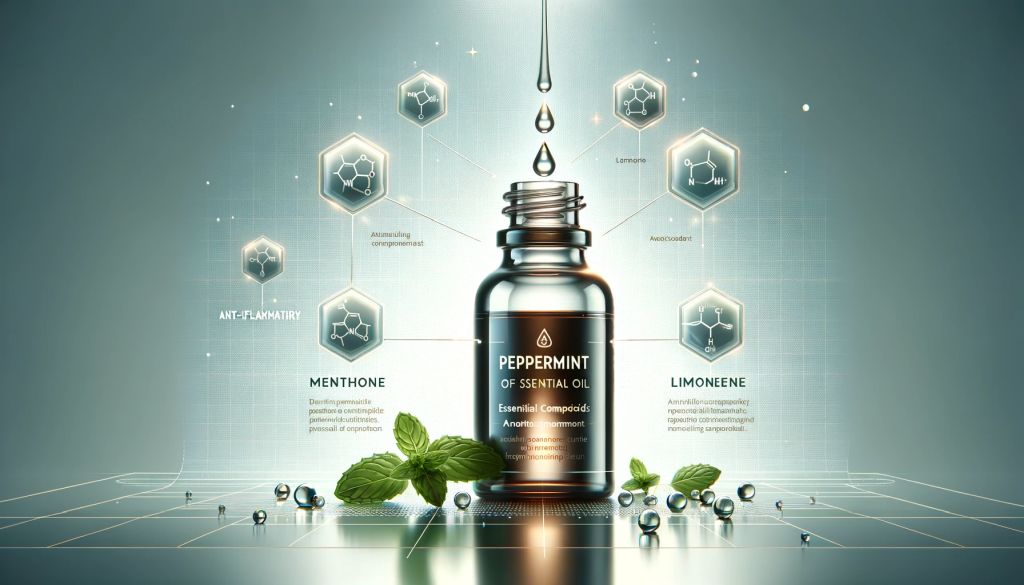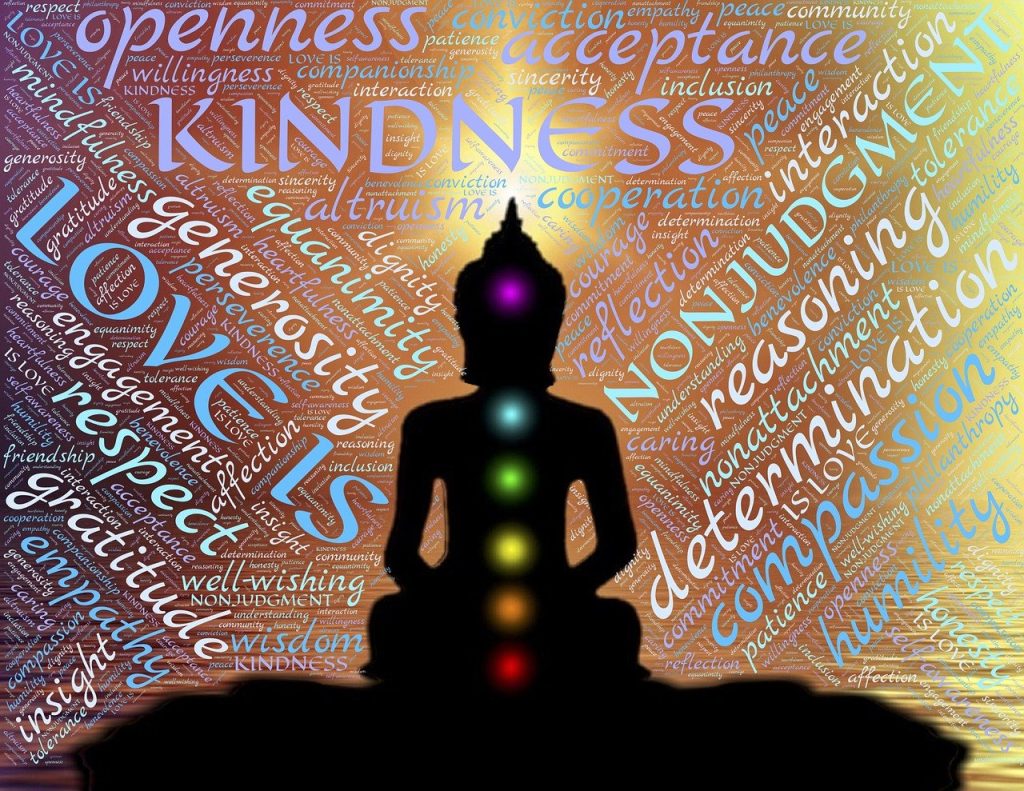
by Health And Healing AI | Nov 25, 2023 | Health
Unveiling the Secrets: How Mint Tea Enhances Your Health & Wellness
If you’re looking for a refreshing and healthy beverage to add to your daily routine, you might want to consider drinking mint tea. Not only is it a delicious drink that can be enjoyed hot or cold, but it also offers a range of health benefits that can improve your overall well-being.

Warm and inviting depiction of mint tea’s refreshing and nourishing qualities.
Mint tea steers fresh or dried mint leaves in hot water. The tea has a cool, refreshing flavor and aroma that can help to soothe your senses and reduce stress. Drinking mint tea can also improve digestion, relieve nausea and headaches, and boost your immune system. Additionally, mint tea is low in calories and sugar, making it a great alternative to sugary drinks like soda and juice.
Research has shown that mint tea may have anti-inflammatory and antioxidant properties, which can help to protect your body against chronic diseases like cancer and heart disease. It can also help to improve your oral health by freshening your breath and reducing the growth of harmful bacteria in your mouth. So, if you’re looking for a simple and natural way to improve your health, try adding a cup of mint tea to your daily routine.
What is Mint Tea
Mint tea is an herbal tea made from the leaves of the mint plant. It is a popular beverage enjoyed worldwide for its refreshing taste and numerous health benefits. Mint tea can be made using diverse types of mint, including peppermint, spearmint, and water mint. Each type of mint has a unique flavor profile and aroma.
Mint tea can be made using tea bags or loose-leaf tea. To prepare a cup of mint tea, place a tea bag or a teaspoon of loose-leaf tea in a cup and pour hot water over it. Let it steep for a few minutes, then remove the tea bag or strain the loose-leaf tea. You can add honey or lemon to sweeten the tea or enjoy it plain.
Fresh mint leaves can also be used to make mint tea. Add a handful of fresh mint leaves to a cup of hot water and let it steep for a few minutes. Strain the leaves and enjoy the tea.
Mint tea is a great alternative to traditional tea and coffee. It is naturally caffeine-free and can be enjoyed any time of the day. The next time you want a refreshing and healthy beverage, try a cup of mint tea.
Nutritional Profile of Mint Tea
Mint tea is a caffeine-free, sugar-free, and low-calorie beverage that is a great alternative to sugary drinks. It is made from the leaves of the peppermint or spearmint plant and has a refreshing and soothing taste.
Mint tea is rich in antioxidants, which help to protect your body from damage caused by free radicals. Free radicals are harmful molecules that can cause cellular damage and lead to chronic diseases such as cancer and heart disease.
In addition to antioxidants, mint tea contains several important nutrients, including vitamins C, A, and potassium. Vitamin C is an essential vitamin that helps to boost your immune system and protect your body from infections. Vitamin A is important for healthful vision, while potassium helps to regulate your blood pressure and keep your heart healthy.
Mint tea is also a major source of hydration. Drinking enough water is essential for good health, and mint tea can help you stay hydrated throughout the day. Studies have shown that drinking tea, including mint tea, can be just as hydrating as drinking water.
Overall, mint tea is a healthy and refreshing beverage that can provide various health benefits. Whether you enjoy it hot or cold, it’s a terrific way to stay hydrated and boost your intake of important nutrients and antioxidants.
Health Benefits of Mint Tea

Professional illustration highlighting menthol’s effect on digestive tract muscles.
Mint tea is a refreshing and delicious beverage consumed for centuries due to its potential health benefits. Here are some of the ways that mint tea may benefit your health:
Digestion
Mint tea is known for its ability to soothe digestive issues such as gas, bloating, and indigestion. The menthol in mint helps to relax the muscles in the digestive tract, which can ease discomfort and promote healthy digestion. Additionally, mint tea may be helpful for those with irritable bowel syndrome (IBS) as it can help to alleviate symptoms such as abdominal pain and bloating.
Cold and Flu
Mint tea may also be beneficial for those suffering from a cold or flu. The antibacterial and antiviral properties of mint can help fight off infections and boost the immune system. Additionally, the menthol in mint can help to relieve congestion and ease coughing.
Nausea and Headaches
Mint tea may also be helpful for those experiencing nausea or headaches. The soothing properties of mint can help to calm the stomach and relieve nausea, while menthol can help to alleviate headaches.
Cognitive Function
Mint tea may also have potential health benefits for cognitive function. The aroma of mint has been shown to improve memory and alertness, making it an excellent choice for when you need to focus and concentrate.
Stress
Finally, mint tea may be helpful for reducing stress and promoting relaxation. The calming properties of mint can help ease tension and promote a sense of calm, making it a wonderful choice for when you need to unwind after a long day.
Overall, mint tea is a delicious and healthy beverage that may offer a range of potential health benefits. Whether you are looking to soothe digestive issues, fight off infections, or simply relax and unwind, mint tea is worth a try!
Mint Tea and Oral Health
Mint tea is a refreshing and delicious beverage that not only tastes great but also has numerous health benefits. One of the most significant benefits of mint tea is its positive impact on oral health.
If you struggle with bad breath, mint tea can help freshen your breath naturally. Mint contains compounds that neutralize the odor-causing bacteria in your mouth, leaving your breath smelling fresh and clean. Instead of relying on chewing gum or breath mints, try sipping on a cup of mint tea after your meals to help keep your breath smelling fresher for longer.
In addition to its breath-freshening properties, mint tea can also help combat plaque buildup in your mouth. Plaque is a sticky film of bacteria that can accumulate on your teeth and gums, leading to tooth decay and gum disease. Drinking mint tea can help reduce the amount of plaque in your mouth, keeping your teeth and gums healthy and clean.
Another benefit of mint tea is that it can help soothe mouth irritation and inflammation. If you have a sore throat or mouth ulcers, sipping on a cup of mint tea can help ease your discomfort. The anti-inflammatory properties of mint can help reduce swelling and pain, making it a natural and effective remedy for oral health issues.
Overall, incorporating mint tea into your daily routine can have numerous benefits for your oral health. Whether you’re looking to freshen your breath, fight plaque, or soothe irritation, a cup of mint tea is a simple and delicious way to support your oral hygiene.
Mint Tea and Essential Oils
Mint tea is not only a delicious and refreshing beverage, but it also offers a wide range of health benefits. One of the most interesting aspects of mint tea is its essential oils. These oils are extracted from the leaves of mint plants and are known for their potent aroma and therapeutic properties.

visualization of essential oil benefits, focusing on pain relief and health effects.
Menthol is one of the primary components of mint essential oils, and it’s responsible for the cooling and soothing sensation that you feel when you drink mint tea. Peppermint oil is one of the most popular mint essential oils, and it’s used for a variety of purposes, including aromatherapy, topical applications, and even in cooking.
Essential oils like peppermint oil contain a variety of other compounds that are beneficial for your health. For example, menthone is a compound that has been shown to have anti-inflammatory and pain-relieving properties. Limonene is another compound found in mint essential oils, and it has been shown to have antioxidant and anti-inflammatory effects.
Aromatherapy is another way to enjoy the benefits of mint essential oils. Simply add a few drops of peppermint oil to a diffuser, and you’ll be able to enjoy the refreshing aroma of mint throughout your home. Aromatherapy has been shown to have various health benefits, including reducing stress and anxiety, improving sleep quality, and boosting mood.
In conclusion, mint essential oils are a powerful and versatile tool for promoting health and well-being. Whether you enjoy mint tea, use peppermint oil for aromatherapy, or incorporate mint essential oils into your cooking, you’ll be able to enjoy the many benefits that these oils have to offer.
Culinary Uses of Mint Tea
Mint tea is not only a healthy drink but also a versatile ingredient that can be used in various culinary applications. The fresh and vibrant flavor of mint tea makes it an excellent addition to many foods and beverages. Here are some of the culinary uses of mint tea that you can try at home:
- Flavoring for Beverages: Mint tea can be used to flavor various beverages, including cocktails, lemonades, and iced teas. You can add a few fresh leaves of mint tea to your favorite beverage to give it a refreshing and cooling taste.
- Flavoring for Foods: Mint tea can also be used to flavor various foods, including salads, sauces, and dressings. You can add a few drops of mint tea to your favorite food to give it a fresh and vibrant flavor.
- Fresh Leaves: Fresh mint leaves can be used to garnish various foods and beverages, including desserts, smoothies, and cocktails. You can also use fresh mint leaves to make a delicious and healthy pesto sauce.
- Taste: Mint tea has a refreshing and cooling taste that can help to soothe your throat and relieve congestion. It is an excellent drink to have when you have a cold or flu.
- Fresh: Mint tea is made from fresh leaves of the mint plant, which gives it a vibrant and fresh taste. You can use fresh mint leaves to make your own mint tea at home.
Overall, mint tea is a versatile ingredient that can be used in various culinary applications. Its fresh and vibrant flavor makes it an excellent addition to many foods and beverages. You can experiment with different recipes and find out which ones work best for you.
Possible Side Effects of Mint Tea

Cautionary visual on mint tea allergies, emphasizing medical attention for symptoms like itching and difficulty breathing.
While mint tea is considered safe to consume in moderation, there are some side effects that you should be aware of.
Allergic Reactions
If you are allergic to plants in the mint family, such as basil, oregano, or sage, you may also be allergic to mint tea. Symptoms of an allergic reaction may include hives, itching, swelling, and difficulty breathing. If you experience any of these symptoms after drinking mint tea, stop consuming it immediately and seek medical attention.
Abdominal Pain and Vomiting
Consuming substantial amounts of mint tea may cause abdominal pain and vomiting, especially in people with a history of gastrointestinal problems. If you experience these symptoms after drinking mint tea, try reducing your intake or stopping it altogether.
Interference with Chemotherapy
Mint tea may interfere with certain chemotherapy drugs, so it is important to talk to your doctor before consuming it if you are undergoing chemotherapy treatment.
Upset Stomach, Heartburn, and GERD
While mint tea is often used to soothe an upset stomach, it may worsen symptoms in some people. If you have gastroesophageal reflux disease (GERD) or experience heartburn or acid reflux, it is best to avoid mint tea.
Kidney Stones
Mint tea contains oxalates, which can contribute to the formation of kidney stones in some people. If you have a history of kidney stones or are at risk of developing them, it is best to limit your intake of mint tea.
Overall, mint tea is a healthy and refreshing beverage that offers many benefits. However, it is important to consume it in moderation and be aware of the possible side effects. If you experience any negative symptoms after drinking mint tea, it is best to speak with your doctor.
Mint Tea Around the World

Illustration of mint tea’s popularity in Europe and Asia with cultural dining settings.
Mint tea is a popular beverage enjoyed around the world. It’s refreshing taste and aroma make it a favorite among tea lovers. In Europe, mint tea is a common drink that is often served after meals. It is believed to aid digestion and freshen breathing. In Asia, mint tea is also popular and is often used for its medicinal properties. It is believed to help relieve headaches, reduce stress, and promote relaxation.
In North America, mint tea is commonly found in grocery stores and is often sold as an herbal tea. It is a great alternative to sugary drinks and is a healthier option. Mint tea is also used as an ingredient in many cocktails and mocktails due to its aromatic flavor.
Mint tea is made by steeping fresh or dried mint leaves in hot water. It can be enjoyed hot or cold and can be sweetened with honey or sugar. Mint tea can be made with several types of mint such as spearmint, peppermint, and apple mint. Each type of mint has its own unique flavor and aroma.
Overall, mint tea is a delicious and healthy beverage that can be enjoyed any time of the day. It is easy to make and can be found in most grocery stores. So, why not try a cup of mint tea today and enjoy its many health benefits?
Conclusion
In conclusion, mint tea is a delicious and healthy beverage that offers numerous health benefits. Whether you prefer peppermint or spearmint, this tea can help alleviate digestive issues, reduce stress and anxiety, and even boost your immune system.
By incorporating mint tea into your daily routine, you can enjoy its refreshing taste and reap the many benefits it has to offer. Try brewing a cup in the morning to start your day off on the right foot or enjoy a cup in the evening to unwind and relax.
Remember to choose high-quality tea leaves and brew your tea properly to get the most out of its health benefits. Experiment with unfamiliar flavors and blends to find the one that suits your taste buds the best.

Evening relaxation scene with a cup of mint tea, emphasizing calm and unwinding moments.
So why not give mint tea a try today? Your body and mind will thank you for it!

by Health And Healing AI | Nov 25, 2023 | Holistic Living
Revitalize Your Well-being: Journey into the World of Alternative Healing
Exploring Alternative Healing: Alternative healing practices have been around for centuries, and today, people are turning to these methods to complement traditional Western medicine.
Alternative healing encompasses a wide range of practices, including acupuncture, herbal medicine, meditation, and yoga, among others.
These practices focus on treating the whole person, rather than just the symptoms of a disease, and can help promote overall health and well-being.

Acupuncture and herbal medicine are set up in a serene environment.
If you’re interested in exploring alternative healing practices, there are many options to choose from, depending on your needs and preferences.
For example, acupuncture is a popular practice that involves inserting thin needles into specific points on the body to promote healing and relieve pain.
Herbal medicine, on the other hand, uses natural remedies made from plants to treat a variety of ailments, from headaches to digestive issues.
Meditation and yoga are also popular practices that can help reduce stress and promote relaxation.
Meditation involves focusing your mind on a particular object, thought, or activity to achieve a state of calm and relaxation.
Yoga combines physical postures, breathing exercises, and meditation to promote physical and mental well-being.
Whether you’re looking to manage stress, relieve pain, or simply improve your overall health, exploring alternative healing practices can be a fantastic way to take control of your health and well-being.
Understanding Alternative Healing
Alternative healing refers to a range of therapies and practices that are not part of conventional medicine.
These therapies aim to treat the whole person, including their physical, emotional, and spiritual well-being.
Alternative healing recognizes that the mind, body, and spirit are connected, and that each aspect of a person’s life affects others.
The goal of alternative healing is to promote health and wellness by addressing the underlying causes of illness, rather than just treating the symptoms.
Alternative healing approaches may include dietary changes, herbal remedies, acupuncture, meditation, yoga, and other mind-body techniques.
These therapies are often used in combination with conventional medicine to provide a more comprehensive approach to health care.
Alternative healing is based on the principle that the body can heal itself, given the right conditions. Practitioners of alternative healing believe that illness is caused by an imbalance in the body’s energy or life force.
By restoring this balance, the body can heal itself and maintain good health.
Alternative healing is not a substitute for conventional medicine, but rather a complementary approach to health care. It is important to consult with a qualified practitioner before beginning any alternative healing therapy.
Your practitioner can help you choose the best approach for your individual needs and can work with your conventional medical doctor to ensure that your treatment is safe and effective.
Types of Alternative Healing
Exploring Alternative Healing: Alternative healing refers to the use of non-traditional methods to treat various health conditions. Here are some common types of alternative healing methods you can explore:
Herbal Medicine
Herbal medicine is the use of plants, plant extracts, and other natural substances to treat various health conditions.
This type of alternative healing has been used for centuries in many cultures around the world. Some popular herbs used in herbal medicine include ginger, garlic, chamomile, and echinacea.
Herbal medicine can come in many forms such as teas, tinctures, capsules, or creams.
Acupuncture
Acupuncture is a traditional Chinese medicine technique that involves the insertion of thin needles into specific points of the body.
This alternative healing method is believed to balance the flow of energy in the body, which can help alleviate pain, reduce stress, and improve overall health.
Acupuncture is often used to treat conditions such as chronic pain, migraines, and anxiety.
Yoga and Meditation
Yoga and meditation are practices that have been used for thousands of years to promote physical, mental, and emotional well-being. Yoga involves a series of poses and breathing exercises that can help improve flexibility, strength, and balance.
Meditation is a technique that involves focusing your attention on a particular object, thought, or activity to achieve a state of calmness and relaxation.
Both practices have been shown to reduce stress, improve sleep, and enhance overall health.
Chiropractic Therapy
Chiropractic therapy is a type of alternative healing that focuses on the musculoskeletal system, particularly the spine.
This method involves the use of manual adjustments and other techniques to align the spine and improve overall health.
Chiropractic therapy is often used to treat conditions such as back pain, neck pain, and headaches.
In conclusion, there are many types of alternative healing methods you can explore to improve your overall health and well-being. It is important to consult with a healthcare professional before trying any new alternative healing method to ensure it is safe and effective for you.
Benefits of Alternative Healing

Modern clinic acupuncture treatment for pain relief.
Alternative healing practices have been around for centuries and are becoming increasingly popular due to their integrated approach to health and wellness. Here are some of the benefits of alternative healing:
Physical Health Benefits
Alternative healing practices such as acupuncture, herbal medicine, and chiropractic care can help alleviate physical pain and discomfort.
Acupuncture, for example, uses thin needles to stimulate certain points in the body, which can help reduce pain and inflammation. Herbal medicine can also help alleviate pain and inflammation, as well as boost the immune system.
Chiropractic care can help improve spinal alignment and reduce pain in the back, neck, and joints.
Alternative healing practices can also help improve overall physical health by promoting healthy habits and lifestyle changes.
For example, meditation and yoga can help reduce stress and improve flexibility and balance. A healthy diet and regular exercise can also help improve physical health and prevent chronic diseases.
Mental Health Benefits
Alternative healing practices can also have a positive impact on mental health.
Meditation, for example, has been shown to reduce stress and anxiety, improve mood, and increase feelings of well-being. Other practices, such as aromatherapy and massage therapy, can also help reduce stress and promote relaxation.
Alternative healing practices can also help improve mental clarity and focus.
For example, acupuncture and herbal medicine can help improve cognitive function and memory. Yoga and meditation can also help improve mental focus and concentration.
In conclusion, alternative healing practices can provide a variety of benefits for both physical and mental health.
By incorporating these practices into your daily routine, you can improve your overall well-being and lead a healthier, happier life.
Risks and Considerations

Professional consultation on alternative healing risks.
When considering alternative healing methods, it is important to be aware of the potential risks and considerations that come with them.
While many alternative healing practices can be safe and effective, there are some potential side effects and interactions with conventional medicine that you should be aware of.
Potential Side Effects
Just like with any type of medication or treatment, there is always the potential for side effects when using alternative healing methods. Some common side effects of alternative healing methods include:
- Allergic reactions: Certain herbal remedies or supplements can cause allergic reactions in some people.
- Symptoms can range from mild itching or hives to more serious reactions like difficulty breathing or anaphylaxis.
- Interference with conventional medications: Some alternative healing methods can interfere with prescription medications, making them less effective or causing unwanted side effects. For example, St. John’s Wort can interfere with the effectiveness of birth control pills and some antidepressants.
- Adverse effects on pre-existing conditions: Some alternative healing methods can worsen pre-existing conditions. For example, acupuncture may not be recommended for people with bleeding disorders or those taking blood thinners.
Interactions with Conventional Medicine
Exploring Alternative Healing: It is important to be aware of the potential interactions between alternative healing methods and conventional medicine.
Some alternative healing methods can interact with prescription medications, making them less effective or causing unwanted side effects.
It is always important to consult with your healthcare provider before starting any new alternative healing method, especially if you are taking prescription medications.
Some common interactions between alternative healing methods and conventional medicine include:
- Herbal remedies and supplements: Many herbal remedies and supplements can interact with prescription medications. For example, ginkgo biloba can interact with blood thinners and increase the risk of bleeding.
- Acupuncture: Acupuncture can interact with prescription pain medications and may increase the risk of bleeding in people taking blood thinners.
- Chiropractic care: Chiropractic care can interact with prescription pain medications and may increase the risk of bleeding in people taking blood thinners.
It is important to talk to your healthcare provider about any alternative healing methods you are considering ensuring that they are safe and effective for you.
Choosing an Alternative Healing Practitioner
When it comes to choosing an alternative healing practitioner, it’s important to do your research and find someone who is qualified and experienced in the specific type of alternative healing you are seeking.

Evaluating credentials medicine therapy.
Here are some things to consider:
Credentials to Look For
- Certifications and Licenses: Look for practitioners who are certified or licensed in their field. For example, if you are seeking acupuncture, make sure the practitioner is licensed by the state.
- Education and Training: Find out where the practitioner received their education and training. Look for reputable schools and programs.
- Experience: Consider how long the practitioner has been practicing and what kind of experience they have. You may want to look for someone who has experience working with your specific condition.
Questions to Ask
- What kind of alternative healing do you specialize in? It’s important to find a practitioner who specializes in the type of alternative healing you are seeking.
- What kind of experience do you have? Ask the practitioner about their experience working with patients with your specific condition.
- What kind of results can I expect? While there are no guarantees with alternative healing, the practitioner should be able to give you an idea of what kind of results you can expect.
- What kind of training and education have you received? Find out where the practitioner received their education and training and what kind of certifications or licenses they hold.
- What kind of fees do you charge? Make sure you understand the fees involved and whether your insurance will cover the cost.
Remember, it’s important to find a practitioner whom you feel comfortable with and whom you trust. Don’t be afraid to ask questions and do your research before choosing an alternative healing practitioner.
Case Studies in Alternative Healing
Alternative healing practices have been gaining popularity in recent years as more people seek alternative treatments for their health concerns.

Clinical research charts graphs on alternative medicine.
Here are some case studies that highlight the effectiveness of alternative healing practices:
Case Study 1: Reconnective Healing
A study published in the National Center for Biotechnology Information found that Reconnective Healing (RH) can reduce pain and improve the range of motion in people with shoulder limitations.
The study also found that exposure of a healer or healee to RH, either directly or indirectly, amplifies their degree of autonomic arousal and energy.
When individuals experience RH as a group, their autonomic nervous system synchronizes, leading to a state of coherence.
These findings suggest that RH can have a positive impact on physical and emotional well-being.
Case Study 2: Traditional Healing
In a study published in the Journal of Traditional and Complementary Medicine, researchers found that traditional healing practices can be effective in treating mental health conditions.
The study looked at the use of traditional healing practices in a rural community in South Africa and found that these practices were effective in reducing symptoms of depression and anxiety.
The researchers also found that traditional healing practices were more accessible and affordable than Western medicine.
Case Study 3: Acupuncture
A study published in the Journal of Pain found that acupuncture can be an effective treatment for chronic pain.
The study looked at patients with chronic low back pain and found that those who received acupuncture had a significant reduction in pain compared to those who received standard care.
The study also found that the effects of acupuncture lasted for up to six months after treatment.
These case studies demonstrate the effectiveness of alternative healing practices in treating a variety of health concerns.
While more research is needed to fully understand the mechanisms behind these practices, they offer a promising alternative to traditional Western medicine.
If you are interested in exploring alternative healing practices, it is important to talk to a qualified practitioner and do your own research to determine what approach is right for you.
Future of Alternative Healing
Alternative healing modalities have been gaining attention in the wellness sphere, offering a variety of approaches to health that differ from conventional Western medicine.
Integrative health and medicine are fields that combine conventional medicine with complementary and alternative medicine (CAM) practices.
The aim of integrative medicine is to treat the whole person, rather than just the symptoms of a disease or condition.
The future of alternative healing looks promising, with more people turning to integrative medicine to address their health concerns.
According to a study published in the Journal of Alternative and Complementary Medicine, the use of CAM therapies in the United States increased from 33.8% in 1990 to 42.1% in 1997 and has continued to increase since then.
This trend is expected to continue as more people become aware of the benefits of integrative medicine.
One of the reasons why integrative medicine is gaining popularity is because it takes a comprehensive approach to health.
This means that it considers all aspects of a person’s life, including their physical, emotional, and spiritual well-being. Integrative medicine also emphasizes the importance of prevention, rather than just treating symptoms.
By focusing on prevention, integrative medicine can help people maintain good health and prevent chronic diseases.
Another reason the future of alternative healing looks promising is because of the advances in technology.
Modern technologies are being developed that allow practitioners to provide personalized treatment plans based on a person’s unique needs and preferences.
For example, some integrative medicine practitioners use genetic testing to identify a person’s risk for certain diseases and develop a personalized plan to prevent those diseases from developing.
Overall, the future of alternative healing looks bright, with an increase in people turning to integrative medicine to address their health concerns.
As technology continues to advance, we can expect to see more personalized treatment plans that take an integrated approach to health.
Conclusion

Holistic health approach in a modern healthcare setting.
Exploring alternative healing methods can be a valuable addition to your overall wellness routine.
By incorporating practices such as acupuncture, herbal medicine, and mindfulness meditation, you can promote physical, emotional, and mental well-being.
One of the key benefits of alternative healing is that it often takes a comprehensive approach to health, treating the whole person rather than just the symptoms of a particular condition.
This can lead to a deeper understanding of your body and mind and help you to develop a greater sense of self-awareness.
Another advantage of alternative healing is that it can often be used in conjunction with conventional medical treatments.
For example, acupuncture has been shown to be effective in reducing pain and nausea in cancer patients undergoing chemotherapy 1.
Similarly, mindfulness meditation has been found to be helpful in managing symptoms of depression and anxiety 2.
It’s important to note that alternative healing methods are not a substitute for professional medical care.
If you have a serious medical condition, it’s important to seek the advice of a qualified healthcare provider.
However, by exploring alternative healing methods, you can take an active role in your own wellness journey and discover new ways to support your health and happiness.

by Health And Healing AI | Nov 20, 2023 | Holistic Living
Embrace Your Authenticity: A Roadmap to Emotional Healing
For years, I lived a life that didn’t belong to me. The pressure to conform, to wear a facade that hid my authentic self, was suffocating.
It was like living in a shadow of who I could be. Each day felt like a scene from a movie, with me playing a role that didn’t fit.
The set was my life—a series of rooms, streets, and interactions—each carefully staged to maintain the illusion.
The script was the expectations of others, their voices echoing in my mind, drowning out my true thoughts and desires. I felt like an actor, reciting lines that were not my own.
But one day, something within me stirred—a desire to peel away the layers of pretense and discover the real me. It was as if the director had called for an unexpected plot twist, and I was ready to take center stage as the hero of my own story.
As the movie of my life continued to play, I embarked on a personal journey of emotional healing and self-discovery that rivaled the most captivating films. It was an epic adventure filled with highs and lows, plot twists, and moments of profound revelation.
Picture a sweeping landscape with rolling hills and valleys, each representing a different emotion and experience.

Your Guide to Healing and Discovery – Transforming Trauma into Triumph. Photo by Cosmic Time Traveler
As I traversed this emotional terrain, I discovered hidden treasures—the truths about who I was and who I could become. It was like stumbling upon a chest of priceless jewels buried beneath the surface.
As you read further, you will join me on this cinematic adventure and be equipped with actionable insights and practical guidance to unlock your authenticity.
Imagine yourself as the protagonist in an inspiring movie. The hero embarks on a quest for self-discovery, confronts challenges head-on, and emerges stronger and wiser.
By the end of this article, you will not imprecate the value of embracing authenticity. But possess the tools to script your emotional narrative of national healing and self-discovery. This story leads to a life enriched with purpose, self-acceptance, and genuine connection with you as the star in the movie of your creation.
Embracing the Real You: A Step-by-Step Roadmap to Authenticity
Navigating Emotions on a Journey to Authenticity
Embracing authenticity is a journey to emotional healing and self-discovery. It is a process of becoming true to yourself, shedding societal expectations, and living a life that aligns with your values and beliefs.
Authenticity is not a destination but a continuous journey that requires self-reflection, self-awareness, and self-acceptance.
When you embrace your authenticity, you become more self-aware and confident in your abilities and decisions. You learn to trust yourself and your intuition, which can help you navigate challenging situations quickly and gracefully.
Authenticity also allows you to connect more deeply with others, as you can show up as your true self and build genuine relationships based on mutual respect and understanding.
However, embracing authenticity is not always easy. It requires vulnerability and courage to show up as your true self, especially when it goes against societal norms or expectations.
It may also require you to confront past traumas or limiting beliefs that have held you back from living authentically.
But the journey is worth it, as it can lead to more incredible emotional healing, self-discovery, and a more fulfilling life.
Understanding Authenticity
Authenticity means being true to oneself and one’s core. It is the ability to express one’s thoughts and beliefs truly.
They are being authentic means being honest with yourself and others and not pretending to be someone you are not.
Definition of Authenticity
Authenticity is often described as the opposite of conformity. It is the ability to be true to yourself, even when your actions go against the norms and expectations of society.
Authenticity is not about being perfect but about being honest and genuine. It is about embracing and accepting your flaws and weaknesses as part of who you are.
Importance of Authenticity
Embracing authenticity is essential for emotional healing and self-discovery. When you are authentic, you are more likely to attract people you are rather than who you pretend to be; this can lead to deeper and more meaningful relationships and a greater sense of belonging.
Being authentic can also help you build self-confidence and self-esteem. When you are true to yourself, you are less likely to compare yourself to others or to try to live up to unrealistic expectations.
This can help your desires and assist them in appreciating your unique qualities and strengths.
It is an essential part of emotional healing, self-confidence, more meaningful relationships, and greater self-confidence and self-esteem.
Journey to Self-Discovery
Self-discovery is the process of exploring and understanding yourself on a deeper level. It involves looking inward and reflecting on your thoughts and feelings. I believe that self-discovery can be challenging, but it can also be gratifying. Here are some steps you can take to think about this journey:
Steps to Self-Action
- Start with self-action: Take some of your dour life and experiences. Think about your strengths, weaknesses, and areas for growth. Consider your values and beliefs and how they shape your decisions and actions.
- Explore your interests: Engage in activities that interest you and try new things. This can help passions and hobbies that you may not have known without judgment. Mindfulness is the practice of being present in the moment and paying attention to your thoughts and feelings without judgment. This can help you become more self-aware and in tune with your emotions.
- Seek feedback: Ask trusted friends, family members, or mentors for feedback on your strengths and areas for improvement. This can give you a new perspective on yourself and help you identify areas to focus on.
Benefits of Self-Awareness make the journey of self-discovery can have numerous benefits, including:
- Improved self-awareness: Understanding yourself deeper can help you make better decisions and improve your relationships with others.
- Increased confidence: When you know who you are and what you stand for, you can make more decisions and actions.
- Greater sense of purpose: Discovering your passions and values can help you find greater meaning and purpose.
- Improved mental health: Self-discovery can help you identify and address underlying emotional issues, improving mental health and well-being.
In conclusion, the journey to self-discovery is a valuable and rewarding process that can help you understand yourself on a deeper level and improve your overall well-being.
By taking the steps outlined above, you can begin your journey to self-discovery.
Emotional Healing
Emotional healing is an essential part of the journey towards self-discovery and authenticity.
It involves recognizing, under, and releasing negative emotions that have been suppressed or repressed within you.
Emotional healing can help you continuously process pain and hurt and move forward with a renewed sense of purpose and clarity.
Understanding Emotional Healing
Emotional healing is not a theme-time vent but a continuous process of self-reflection and growth.
It requires you to be honest and confront the emotions you have avoided or suppressed.
This process can be complicated, but it is necessary for your emotional well-being.
Emotional healing has several benefits, including increased self-awareness, improved mental health, and better relationships with others.
When you heal emotionally, you become more aware of your thoughts and feelings, which can help you make better decisions and live a more fulfilling life.
Techniques for Emotional Healing
There are several techniques that you can use to facilitate emotional healing. These include:
- Journaling: Writing down your thoughts and feelings can be a powerful tool for emotional healing. It allows you to express yourself freely and release negative emotions safely and healthily.
- Mindfulness: Practicing mindfulness can help you become more aware of your thoughts and emotions. This can help you recognize negative patterns and behaviors and make positive changes in your life.
- Therapy: Seeking the help of a therapist or counselor can be an effective way to address past traumas and negative emotions. They can provide the tools and support you need to heal emotionally.
- Self-care: Taking care of yourself physically, emotionally, and mentally is essential for emotional healing. This can include getting enough sleep, eating a healthy diet, exercising regularly, and engaging in activities that bring you joy.
Embracing emotional healing allows one to begin letting go of negative emotions and moving forward with a renewed sense of purpose and clarity.
Remember that emotional healing is a continuous process that takes time and effort to achieve.
Be patient with yourself and seek the help and support you need along the way.
The Role of Authenticity in Emotional Healing
Emotional healing is a journey that requires a deep understanding of oneself.
One of the critical components of this journey is embracing authenticity. Authenticity means being true to yourself, your values, and your beliefs.
It means being honest about who you are and what you want.
When you embrace authenticity, you let go of the masks you wear to fit in and step into your true self. This process can be challenging, but it is essential for emotional healing.
It allows you to connect with your true feelings and emotions, which can be difficult when you constantly try to please others.
Research suggests that authenticity is linked to higher levels of self-esteem, happiness, and life satisfaction and lower levels of anxiety and depression.
You are more likely to feel fulfilled and content when you are true to yourself.
You are also more likely to attract positive people and experiences into your life.
One way to embrace authenticity is to reflect on your values and beliefs. List what is important to you and what you stand for.
This can help you identify areas where you may be compromising your values or beliefs.
Another way to embrace authenticity is to practice self-acceptance.
Accepting yourself for who you are, flaws and all, is a crucial step in the journey to emotional healing. It lets you let go of self-judgment and criticism and embrace your true self.
In conclusion, embracing authenticity is a crucial component of the journey to emotional healing.
It allows you to connect with your true feelings, which can be difficult when you constantly try to please others. By embracing authenticity, you can live a more fulfilling and purposeful life.
Overcoming Challenges in the Journey
Common Obstacles
As you embark on your journey to emotional healing and self-discovery, you must be aware of the common obstacles that may arise.
These obstacles can sometimes make you want to give up, but you can overcome them with the right mindset and strategies.
One of the most common obstacles is fear.
Fear of the unknown, fear of failure, and fear of rejection can all hold you back from being your authentic self. It’s vital to acknowledge your fears but not let them control you.
Remember that fear is a natural part of growth and change; facing your fears can lead to personal transformation.
Another obstacle is self-doubt. It’s easy to doubt yourself when trying something new or taking a risk.
But remember that self-doubt is just a thought that can be changed. Instead of focusing on your doubts, focus on your strengths and accomplishments.
Remind yourself of times when you succeeded and trust in your abilities.
Effective Strategies
Now that you’re aware of some familiar obstacles, it’s essential to have effective strategies for overcoming them.
Here are a few strategies that can help you on your journey:
- Practice self-compassion: Be kind to yourself, especially when you face challenges or setbacks. Treat yourself like you would treat a good friend.
- Set realistic goals: Break down your larger goals into smaller, achievable steps. Celebrate each step you take towards your goal.
- Embrace vulnerability: Being vulnerable can be scary, but it can also lead to deeper connections with others and a greater sense of self-acceptance.
- Seek support: Surround yourself with people who support and encourage you. This can be friends, family, or a therapist.
Remember that the journey to emotional healing and self-discovery is not always easy, but it’s worth it.
By being aware of common obstacles and having effective strategies, you can overcome challenges and continue your path toward authenticity.
Case Studies of Authenticity and Emotional Healing
Embracing authenticity can lead to emotional healing and self-discovery. Here are a few case studies that show how authenticity helped individuals overcome emotional challenges.
Case Study 1: John
John was a successful businessman but felt like he was living a double life.
He felt like he was constantly wearing a mask because he was hiding his true self from his colleagues and friends.
This led to feelings of anxiety and depression. John decided to embrace authenticity and started to be more open about his true self. He shared his hobbies, passions, and interests with his colleagues and friends.
This led to deeper connections and a sense of belonging. John’s anxiety and depression decreased, and he felt more fulfilled in his personal and professional life.
Case Study 2: Sarah
Sarah had a traumatic childhood and struggled with trust issues.
She had a tough time opening to people and was afraid of vulnerability. Sarah decided to embrace authenticity and started to share her story with others. She found a supportive community that helped her heal and grow.
Sarah’s relationships improved, and she felt more confident connecting with others.
Case Study 3: Michael
Michael struggled with addiction and felt like he was living a lie. He was afraid to be honest with himself and others about his struggles. Michael decided to embrace authenticity and started to attend support groups. He shared his story with others and found a sense of belonging.
Michael’s addiction decreased, and he felt more in control of his life.
These case studies show that embracing authenticity can lead to emotional healing and self-discovery. By being true to yourself, you can connect with others deeply and find a sense of belonging.
Conclusion
In conclusion, embracing authenticity is a powerful journey toward emotional healing and self-discovery.
By being true to yourself and accepting your strengths and weaknesses, you can experience freedom and inner peace from living an authentic life.
Throughout this article, we have explored the significance of knowing ourselves, free from fear and societal pressure.
We have also discussed how emotional healing goes beyond overcoming distressing experiences and involves integrating all aspects of ourselves, including our emotions, thoughts, and behaviors.
To start your journey towards embracing authenticity, it is essential to practice self-awareness and self-acceptance.
This involves recognizing your emotions, thoughts, and behaviors without judgment and being kind to yourself. You can also seek support from friends, family, or a professional counselor to help you navigate the journey.
Remember that authenticity is not a destination but a continuous process of self-discovery and growth. By embracing your true self, you can experience enhanced mental well-being and live a fulfilling life.

by Health And Healing AI | Nov 20, 2023 | Holistic Living
Unveiling the Transformation: Escaping Chronic Pain to Find Vitality
Life had once been a vibrant tapestry of experiences, but chronic pain had woven its dark threads into every aspect of my existence.

Lessons Learned: Wisdom Gained on the Path to Vitality. Photo by Pixabay
It was as if I lived in a shadowed world, unable to escape the clutches of discomfort and despair. Every day felt like a never-ending storm, and I longed for the sun’s soothing rays to break through the clouds.
But one day, a flicker of determination ignited within me—a spark of hope that would change everything.
It was as though a single, distant star had caught my eye in the pitch-black night, promising a way out of the darkness. I couldn’t ignore it; I had to follow its faint glimmer.
As I embarked on my journey from chronic pain to vitality, it was like stepping onto a treacherous path shrouded in mist.
The path was riddled with obstacles, and I sometimes stumbled and fell. But with each fall, I grew more robust, and the mist began to lift with every step.
The transformation I experienced was akin to witnessing the changing seasons. I started in the bitter cold of winter, where pain froze my every move. But as I persevered, spring arrived with its promise of new beginnings.
My body and spirit thaw and my world burst into vibrant colors.
I discovered the science of healing and the art of living through my journey. The steps I took were not just about managing pain; they were about rediscovering life’s beauty and regaining control.
Imagine a vivid scene where the first buds of a cherry blossom tree unfurl, delicate and pink, after a harsh winter. That’s what it felt like as vitality began to blossom within me.
As you join me on this cinematic voyage of transformation, picture yourself as the protagonist in an epic story, where the hero faces adversity, overcomes challenges, and emerges stronger and wiser.
Through the upcoming pages, you will uncover actionable insights akin to discovering hidden treasures and concrete strategies that can lead you from the darkness of chronic pain to the radiant light of vitality.
By the end of this article, you will not only hold a tangible roadmap to your journey but also feel the sun’s warmth on your face after a long, cold night—a promise of renewed life, energy, and boundless vitality.
A Triumph Over Pain: A Personal Odyssey to Rediscover Vitality
If you are someone who has been living with chronic pain, you know how much it can impact your life. From limiting your ability to perform daily tasks to affecting your mood and overall quality of life, chronic pain can be a constant burden. However, there are ways to manage chronic pain and improve your overall health and vitality.
One of the most important things you can do when living with chronic pain is to work with a healthcare provider who understands your condition and can help you develop a personalized treatment plan. This may include a combination of medication, physical therapy, and lifestyle changes such as exercise, stress reduction techniques, and dietary changes. By working with a healthcare provider, you can develop a plan that addresses your specific needs and helps you manage your pain more effectively.
In addition to working with a healthcare provider, there are also many self-care strategies you can use to improve your overall health and vitality. These may include things like practicing mindfulness, getting enough sleep, staying hydrated, and eating a healthy, balanced diet. By focusing on your overall health and well-being, you can help reduce your pain and improve your quality of life.
Understanding Chronic Pain
Defying the Odds: How This Journey Redefined the Meaning of Health
Transformative Journey: Please Click the URL and Enjoy https://www.youtube.com/watch?v=AvkscRi4r7c&embed=true
Chronic pain is a complex condition that affects millions of people worldwide. It is defined as pain that persists for more than three months and can be caused by a variety of factors, including injury, illness, or nerve damage. Chronic pain can be debilitating and can significantly impact your quality of life.
There are many different types of chronic pain, including neuropathic pain, which is caused by damage to the nerves, and nociceptive pain, which is caused by tissue damage. Chronic pain can also be classified as somatic pain, which is pain that originates in the muscles, bones, or joints, or visceral pain, which is pain that originates in the organs.
Chronic pain can be difficult to manage, and there is no one-size-fits-all approach to treatment. However, there are many different treatment options available, including medication, physical therapy, and alternative therapies such as acupuncture and massage.
It is important to understand that chronic pain is a real and valid condition that should not be dismissed or ignored. If you are experiencing chronic pain, it is important to seek help from a healthcare professional who can help you develop a personalized treatment plan that addresses your specific needs and concerns.
Here are some common causes of chronic pain:
| Cause of Chronic Pain | Description |
|---|
| Arthritis | Inflammation of joints |
| Fibromyalgia | Widespread musculoskeletal pain |
| Migraines | Intense headaches |
| Back pain | Pain in the lower back |
| Nerve damage | Damage to the nerves |
| Cancer | Pain caused by cancer or cancer treatments |
If you are experiencing chronic pain, it is important to keep track of your symptoms and communicate openly with your healthcare provider. Together, you can develop a treatment plan that addresses your pain and helps you live a more active and fulfilling life.
The Impact of Chronic Pain on Life
Chronic pain is a condition that affects millions of people worldwide. Unlike acute pain, which is a normal response to injury or illness and usually goes away as the underlying condition heals, chronic pain persists for months or even years. It can be caused by a variety of factors, including injury, illness, or an underlying medical condition.
Living with chronic pain can have a significant impact on your life. It can affect your ability to work, sleep, and enjoy daily activities. Chronic pain can also lead to feelings of anxiety, depression, and isolation.
According to a study published in the Lancet, chronic pain affects more than 30% of people worldwide. It can be categorized as nociceptive, neuropathic, or mixed, and can be further classified as mild, moderate, or severe.
Chronic pain can also be classified by its impact on daily activities, with high-impact chronic pain being the most severe form.
Research has shown that chronic pain can lead to a decrease in quality of life. A study published in Sage Journals found that chronic pain has a multidimensional negative impact on patients’ quality of life. This impact is more significant than that of other long-term conditions and the general population.
In addition to affecting your physical and emotional well-being, chronic pain can also have financial implications. It can lead to increased healthcare costs, lost productivity, and reduced earning potential.
If you are living with chronic pain, it is essential to seek medical attention and explore treatment options. Working with a healthcare professional can help you manage your pain and improve your quality of life.
Path to Vitality: Lifestyle Changes
Living with chronic pain can be challenging, but there are ways to manage your pain and improve your quality of life. In addition to medical treatments, lifestyle changes can make a significant difference in managing chronic pain. Here are some lifestyle changes you can make to help you move from chronic pain to vitality:
Nutrition for Pain Management
Your diet can play a crucial role in managing chronic pain. Certain foods can trigger inflammation and worsen pain, while others can help reduce inflammation and alleviate pain. A healthy and balanced diet can also help you maintain a healthy weight, which can reduce the strain on your joints and muscles.
To manage pain, you should focus on consuming anti-inflammatory foods such as:
- Fruits and vegetables
- Whole grains
- Lean protein sources like fish and chicken
- Healthy fats like avocados, nuts, and olive oil
On the other hand, you should avoid or reduce the intake of foods that can trigger inflammation, such as:
- Processed foods
- Sugary drinks and snacks
- Red meat
- Foods high in saturated and trans fats
Exercise and Movement

The Power of Resilience: How One Person Emerged from Pain. Photo by Nicolas Hoizey
Exercise and movement are essential for managing chronic pain. Regular exercise can help reduce pain, improve flexibility, and strengthen muscles. It can also help you maintain a healthy weight and improve your overall health and well-being.
When it comes to exercise, it’s essential to find a routine that works for you. Low-impact exercises such as walking, swimming, and cycling can be an excellent choice for people with chronic pain. Stretching and yoga can also help improve flexibility and reduce pain.
In addition to exercise, it’s also essential to stay active throughout the day. Sitting or standing in one position for too long can worsen pain and stiffness. Try to move around every 30 minutes, even if it’s just to stretch or take a short walk.
Making lifestyle changes can be challenging, but with time and patience, you can see significant improvements in managing chronic pain. By focusing on nutrition and exercise, you can move from chronic pain to vitality and enjoy a better quality of life.
Mind-Body Techniques for Pain Relief
If you’re experiencing chronic pain, you may feel like you’ve tried everything to find relief. However, there are a variety of mind-body techniques that can help you manage your pain and improve your overall well-being. Here are two techniques that have been shown to be effective:
Meditation and Mindfulness
Meditation and mindfulness are practices that involve focusing your attention on the present moment. By doing so, you can reduce stress and anxiety, which can help to alleviate pain. Research has shown that meditation can help reduce the intensity and unpleasantness of chronic pain 1. There are many different types of meditation, including:
- Breathing meditation: This involves focusing your attention on your breath as you inhale and exhale.
- Body scan meditation: This involves systematically scanning your body for sensations and focusing your attention on each one.
- Loving-kindness meditation: This involves focusing your attention on sending loving-kindness to yourself and others.
Cognitive Behavioral Therapy
Cognitive behavioral therapy (CBT) is a type of talk therapy that can help you change negative thought patterns and behaviors. It has been shown to be effective in reducing chronic pain 2. During CBT, you’ll work with a therapist to identify negative thoughts and behaviors that may be contributing to your pain. You’ll then learn strategies to replace these thoughts and behaviors with more positive ones.
CBT can be done in individual or group settings and can be particularly helpful for people with chronic pain who also have depression or anxiety.
In conclusion, meditation and mindfulness, as well as cognitive behavioral therapy, are two mind-body techniques that can help you manage your chronic pain. By incorporating these practices into your daily routine, you may find that your pain is more manageable, and your overall well-being improves.
Medical Interventions

Trials and Triumphs: Navigating the Maze of Chronic Pain. Photo by Mat Napo
If you’re experiencing chronic pain, there are several medical interventions that can help you manage your pain and improve your quality of life. Two main types of medical interventions are pharmacological and non-pharmacological treatments.
Pharmacological Treatments
Pharmacological treatments involve the use of medication to manage pain. Some common medications used to manage chronic pain include:
- Nonsteroidal anti-inflammatory drugs (NSAIDs): NSAIDs, such as ibuprofen and naproxen, are commonly used to relieve pain and reduce inflammation.
- Opioids: Opioids, such as morphine and oxycodone, are prescription medications that are used to manage severe pain. However, they can be addictive and have serious side effects, so they should be used with caution.
- Antidepressants: Some antidepressant medications, such as amitriptyline and duloxetine, can be used to manage chronic pain, even if you’re not experiencing depression.
- Anticonvulsants: Some anticonvulsant medications, such as gabapentin and pregabalin, can be used to manage chronic pain, particularly nerve pain.
Non-Pharmacological Treatments
Non-pharmacological treatments involve techniques and therapies that don’t involve medication. Some common non-pharmacological treatments used to manage chronic pain include:
- Physical therapy: Physical therapy can help you improve your strength, flexibility, and range of motion, which can help reduce pain and improve your overall function.
- Acupuncture: Acupuncture involves the insertion of thin needles into specific points on your body to help relieve pain.
- Massage therapy: Massage therapy can help relieve muscle tension and reduce pain.
- Cognitive-behavioral therapy (CBT): CBT is a type of talk therapy that can help you learn how to manage your pain by changing the way you think about it.
It’s important to work with your healthcare provider to determine the best treatment plan for you. They can help you weigh the benefits and risks of different treatments and develop a plan that works best for your individual needs.
Support Systems and Chronic Pain Management
Living with chronic pain can be a challenging experience that can affect your physical, emotional, and mental health. However, building a support network and seeking professional help can help you manage your symptoms and improve your quality of life. In this section, we will discuss the importance of support systems and chronic pain management.
Building a Support Network
Having a support network can help you cope with the challenges of chronic pain. You can build a support network by reaching out to your family, friends, and loved ones. Let them know how they can help you, such as running errands, cooking meals, or simply listening to you when you need to talk.
You can also join support groups, both online and in-person, where you can connect with others who are going through similar experiences. Support groups can provide you with a safe space to share your feelings, learn coping strategies, and find emotional support.
Professional Help and Counseling
Professional help and counseling can also be an important part of chronic pain management. Your healthcare provider can help you develop a treatment plan that includes medication, physical therapy, and other pain management strategies.
Counseling can also help you cope with the emotional and mental effects of chronic pain. A mental health professional can help you develop coping strategies, manage stress and anxiety, and improve your overall quality of life.
In conclusion, building a support network and seeking professional help can help you manage your chronic pain symptoms and improve your quality of life. Don’t be afraid to reach out for help and support, as it can make a significant difference in your well-being.
Conclusion: Embracing a Life of Vitality
Congratulations on taking the first step towards embracing a life of vitality! Chronic pain can be a debilitating condition that affects every aspect of your life. However, with the right mindset and tools, you can overcome this challenge and live a fulfilling life.
Throughout this article, we have discussed the importance of mindfulness and acceptance-based interventions in managing chronic pain. We have explored the concept of vitality and how it can be used as a framework for improving your quality of life.
Remember, vitality is not just about physical energy but also about retaining enthusiasm and spirit. It is about finding joy in the simple things in life and being present in the moment. By incorporating vitality training into your daily routine, you can cultivate a sense of purpose and meaning in your life.
Here are a few key takeaways to help you on your journey towards vitality:
- Practice mindfulness: Mindfulness can help you become more aware of your thoughts and emotions, allowing you to better manage stress and anxiety.
- Embrace acceptance: Acceptance does not mean giving up or resigning yourself to a life of pain. Instead, it means acknowledging your pain and learning to work with it.
- Stay active: Regular physical activity can help reduce pain and improve your overall well-being.
- Cultivate positive relationships: Surround yourself with people who support and encourage you.
Remember, the journey toward vitality is not a quick fix. It takes time and effort to develop new habits and ways of thinking. However, with patience and persistence, you can overcome chronic pain and live a life full of vitality.

by Health And Healing AI | Nov 17, 2023 | Mindfulness
Empower Your Spirit: A Meditative Journey to Unshakeable Peace
Have you ever been trapped in the relentless whirlwind of life’s demands, yearning for solace and tranquility?
I certainly did. There was a time when stress, anxiety, and the ceaseless chatter of my mind felt overwhelming.
I often wondered if inner peace was more than a compelling dream reserved for those with some elusive secret.
During one of my most trying moments, I stumbled upon something remarkable—an oasis amidst the chaos of existence.
This sanctuary existed within me all along. It was the day I discovered a meditation script, a simple yet profound tool that would forever alter the course of my life.

Guided meditation session with a soothing voice for achieving inner peace. Photo by Eriks Cistovs
As I share this deeply personal journey with you, I aim to empathize with the turbulence you might be experiencing in your own life.
I understand the demands of the modern world, the weight of responsibilities, and the constant stream of distractions that can leave you feeling adrift. I’ve been there, and I know how it feels.
In the following article, I invite you to join me on a profound exploration—a quest to unearth the treasure of inner peace.
Through this script’s lens, you’ll gain knowledge and a profound understanding of navigating the turbulent waters of existence.
By the end of this article, I promise you more than just a roadmap; I promise you a lifeline to that elusive inner peace you’ve been yearning for, which is tangible, transformative, and within your reach.
Mastering Calm: A Comprehensive Meditation Script for Inner Peace
If you’re looking to start meditating practice, using a meditation script can be a helpful tool to guide you through the process.
A meditation script is a written set of instructions that walk you through meditation practice, often including prompts for visualization or body awareness. These scripts can be used for personal meditation practice or by teachers leading group meditation sessions.
Using a meditation script can be especially helpful for beginners who may find it difficult to quiet their minds or focus on their breath.
By following along with a script, you can stay on track and avoid getting distracted by thoughts or external stimuli. Additionally, meditation scripts can be tailored to meet specific goals, such as reducing anxiety or increasing self-compassion.
Understanding Meditation
Definition of Meditation
Meditation is a practice that involves focusing your mind on a particular object, thought, or activity to achieve a state of mental clarity and emotional calmness. It is a technique that has been used for centuries to promote relaxation, reduce stress, and enhance overall well-being.
There are many different types of meditation, including mindfulness meditation, loving-kindness meditation, and transcendental meditation. Each type of meditation has its own unique benefits and can be practiced by anyone, regardless of their age, background, or level of experience.
Benefits of Meditation
Meditation has been shown to have numerous benefits for both the mind and body. Some of the most common benefits of meditation include:
- Reducing stress and anxiety
- Improving sleep quality
- Boosting immune system function
- Lowering blood pressure
- Enhancing focus and concentration
- Increasing feelings of happiness and well-being
In addition to these benefits, meditation can also help you develop a greater sense of self-awareness and compassion for others.
By regularly practicing meditation, you can learn to better understand your own thoughts and emotions, as well as the thoughts and emotions of those around you.
This increased awareness can lead to greater empathy and understanding, which can help you build stronger relationships with others and lead a more fulfilling life.
Preparation for Meditation
Before you begin your meditation practice, it’s important to prepare yourself and your environment. Here are a few things to keep in mind:
Choosing a Quiet Place
Find a quiet and peaceful place where you won’t be disturbed. This could be a spare room in your house, a quiet corner of your garden, or a nearby park. Make sure the space is clean and free from clutter.
You can also use a meditation app to help create a peaceful environment with calming background sounds.
Comfortable Sitting Position
Choose a comfortable sitting position that allows you to relax and focus on your breath. You can sit on a cushion, a yoga mat, or a chair. Keep your back straight and your shoulders relaxed. You can cross your legs if you’re sitting on the floor or keep your feet flat on the ground if you’re sitting on a chair. Place your hands on your lap, with your palms facing up or down.
Remember, the most important thing is to be comfortable, so experiment with various positions until you find one that works for you.
By creating a peaceful environment and choosing a comfortable position, you’ll be able to focus on your breath and get the most out of your meditation practice.
Basic Meditation Script
Meditation is a simple and effective way to reduce stress, improve focus, and increase overall well-being. A basic meditation script can help you get started with your practice. Here is a simple script to help you get started:
Step 1: Find a Quiet Place
Find a quiet place where you won’t be disturbed. This could be a room in your home, a park, or any other quiet place where you feel comfortable.
Step 2: Get Comfortable
Sit in a comfortable position with your back straight and your feet flat on the ground. You can sit on a cushion or a chair, whichever is more comfortable for you.
Step 3: Close Your Eyes
Close your eyes and take a few deep breaths. Inhale deeply through your nose and exhale through your mouth.
Step 4: Focus on Your Breath
Focus your attention on your breath. Notice the sensation of the air moving in and out of your body. If your mind wanders, gently bring your attention back to your breath.
Step 5: Let Your Thoughts Pass
As you focus on your breath, thoughts and distractions may arise. Don’t worry, this is normal. Simply acknowledge the thoughts and let them pass by gently bringing your attention back to your breath.
Step 6: End Your Session
When you are ready to end your meditation session, take a few deep breaths and slowly open your eyes. Take a moment to notice how you feel and carry that feeling with you throughout your day.
This basic meditation script is a great starting point for beginners. With practice, you can increase the duration of your meditation sessions and explore different techniques to find what works best for you.
Remember, the most important thing is to make meditation a regular part of your routine to experience its benefits.
Mindfulness Meditation Script

The Art of Stillness: Meditation Script for Profound Inner Peace. Photo by Max
If you’re new to meditation or looking to refresh your practice, guided mindfulness meditation scripts can be a great starting point.
This type of meditation involves focusing your attention on the present moment, without judgment or distraction. It can help alleviate stress, increase relaxation, and improve overall well-being.
To begin, find a quiet space where you won’t be disturbed. Set a time for your meditation, whether it’s five minutes or an hour. Sit in a comfortable posture, with your back straight and your feet firmly planted on the ground.
You can also lie down if you prefer.
Next, focus on your breath. Take a few deep breaths, inhaling through your nose and exhaling through your mouth. Then, allow your breath to return to its natural rhythm. You can count your breaths if it helps you stay focused.
As you continue to breathe, begin to observe your thoughts without judgment. Imagine your thoughts as clouds pass by in the sky. You don’t need to hold onto them or push them away, just observe them as they come and go.
If you find your mind wandering, gently bring your attention back to your breath. You can also use a mantra, or a word or phrase, to help you stay focused. Repeat your mantra silently to yourself with each inhale and exhale.
There are many different guided mindfulness meditation scripts available, each with its own focus and intention. Some scripts may focus on self-love or compassion, while others may focus on stress reduction or releasing negative emotions.
Experiment with different scripts to find what works best for you.
Remember, the goal of mindfulness meditation is not to eliminate all thoughts but rather to observe them with curiosity and compassion. With practice, you can cultivate a greater sense of peace and well-being in your daily life.
Guided Visualization Meditation Script
If you’re new to meditation, guided visualization meditation scripts can be a fantastic way to start. Visualization meditation is a form of meditation that uses the power of imagination to calm the mind and reduce stress.
It involves creating a mental image of a peaceful place or situation and focusing on that image to quiet your thoughts.
Guided visualization meditation scripts are pre-written scripts that guide you through the meditation process step by step. They can be read out loud by a meditation teacher or recorded and listened to at your own pace.
These scripts often include detailed descriptions of the peaceful setting you are visualizing, as well as instructions for breathing and relaxation techniques.
One example of a guided visualization meditation script is the “Starry Sky” script from Inner Health Studio [1]. This script guides you through imagining yourself lying on your back in a field at dusk, watching the stars appear in the night sky.
The script includes instructions for deep breathing and progressive muscle relaxation to help you relax and focus on the visualization.
Another example is the “Loving Kindness Visualization” script from Mindfulness Exercises [2]. This script guides you through imagining yourself surrounded by spheres of light, each representing a different person in your life.
You focus on sending love and kindness to each sphere, one by one, until you feel a sense of warmth and connection.
Guided visualization meditation scripts can be a helpful tool for beginners or anyone looking to deepen their meditation practice.
They offer a structured way to focus your mind and reduce stress and can be customized to fit your individual needs and preferences.
Loving Kindness Meditation Script

Journey to Serenity: Discovering Inner Peace through Love and Meditation. Photo by johnhain
Loving Kindness Meditation, also known as Metta Meditation, is a practice that involves cultivating love, kindness, and compassion towards oneself and others. It is a simple yet powerful technique that can help reduce stress, anxiety, and negative emotions while increasing positive feelings and overall well-being.
To begin, find a comfortable seated position with your back straight and your eyes closed. Take a few deep breaths, and then suggest an image of yourself. Repeat the following phrases silently to yourself, focusing on the meaning behind each one:
- May I be happy
- May I be healthy
- May I be safe
- May I live with ease
After a few minutes, shift your focus to someone you care about, such as a friend or family member. Repeat the same phrases, replacing “I” with their name or pronoun:
- May [Name] be happy
- May [Name] be healthy
- May [Name] be safe
- May [Name] live with ease
Next, extend your focus to include all beings, repeating the phrases:
- May all beings be happy
- May all beings be healthy
- May all beings be safe
- May all beings live with ease
You can also customize the phrases to fit your own needs or preferences. For example, you might say:
- May I be filled with love and compassion
- May [Name] be free from suffering
- May all beings be free from fear and anxiety
The key is to cultivate a sense of warmth, kindness, and goodwill towards yourself and others.
By practicing Loving Kindness Meditation regularly, you can develop a more positive outlook on life and deepen your connections with those around you.
To deepen your understanding of Loving Kindness Meditation, you can refer to the PDF Transcript for the Loving Kindness Meditation or the Loving-Kindness Meditation Guide by Greater Good in Action.
Body Scan Meditation Script
If you’re new to meditation, a body scan meditation script is a wonderful place to start. This type of meditation can help you develop attention and mindfulness practices.
The goal of a body scan meditation is to focus on specific body parts and cultivate present-moment awareness.
To begin, find a quiet place where you can sit or lie down comfortably. Close your eyes and take a few deep breaths. As you breathe, focus on the sensation of your breath moving in and out of your body.
Next, begin to scan your body from your toes all the way up to the top of your head. Pay attention to any sensations you feel in each body part. You might notice tension, warmth, or tingling. Simply observe these sensations without judgment.
As you scan your body, you can use a script to guide you through the process. There are many body scan meditation scripts available online, including the one provided by the Veterans Affairs. This script suggests starting at your feet and working your way up your body, spending a few moments on each body part.
Remember, the goal of a body scan meditation is not to change anything about your body or your sensations. Instead, it’s about cultivating awareness and acceptance of your body as it is in the present moment.
If you find your mind wandering during the meditation, gently bring your attention back to your breath and your body. With practice, you’ll find it easier to stay focused and present during your meditations.
Conclusion
In conclusion, meditation scripts can be incredibly helpful in guiding you through meditation practice. Whether you are a beginner or an experienced meditator, using a script can help you stay focused and calm.
Remember, there is no one-size-fits-all approach to meditation. It’s important to find a script that resonates with you and your personal goals. Take the time to explore different scripts and find the one that feels right for you.
Additionally, don’t be afraid to customize a script to better suit your needs. If there is a particular phrase or visualization that doesn’t resonate with you, feel free to modify it or replace it with something that does.
Finally, it’s important to remember that meditation is practice. It takes time and patience to develop a consistent practice, but the benefits are well worth it. So, take it one day at a time, be kind to yourself, and enjoy the journey.
























